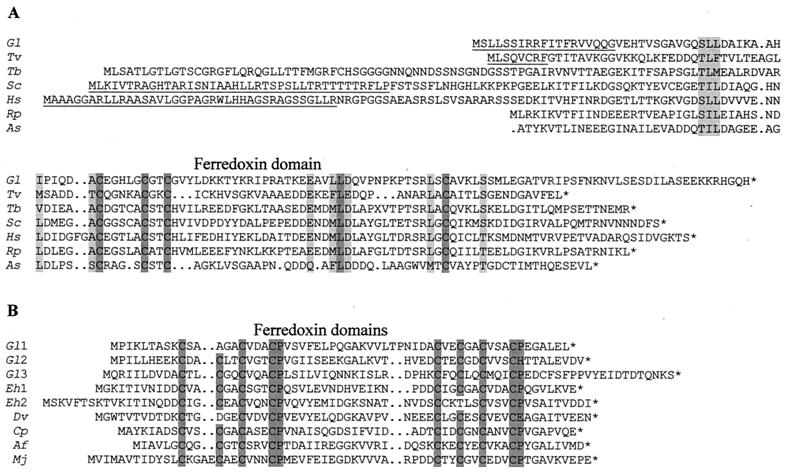FIG. 2.
Putative ferredoxins of G. lamblia and E. histolytica. (A) Alignment of a hypothetical [2Fe-2S]ferredoxin of G. lamblia (Gl) (GenBank accession number AF393829) in single-letter code with those of other eukaryotes (T. vaginalis [Tv] [102172], Trypanosoma brucei [Tb] [incomplete microbial genome database], S. cerevisiae [Sc] [6325004], and H. sapiens [Hs] [4758352]) and eubacteria (Rickettsia prowazekii [Rp] [15604072] and Aphanothece sacrum [As] [119940]). Cys residues, which form ligands with the iron-sulfur site, and other residues identical in these ferredoxins are shaded in dark gray. Residues with conservative amino acid substitutions are shaded in light gray. N-terminal organelle-targeting sequences, which are proven (T. vaginalis, S. cerevisiae, and H. sapiens) or hypothetical (G. lamblia), are underlined (10, 14). An asterisk indicates the end of each protein. Gaps are indicated by dots. (B) Alignment of three hypothetical 6-kDa ferredoxins of G. lamblia (Gl1 to Gl3) with selected ferredoxins of E. histolytica (Eh1 and Eh2) (GenBank accession number 158942), eubacteria (Desulfovibrio vulgaris [Dv] [944972] and Clostridium perfringens [Cp] [119990]), and archaea (Archaeglobus fulgidus [Af] [11499725] and Methanococcus jannaschii [Mj] [15668371]). Residues are shaded as described for panel A.

